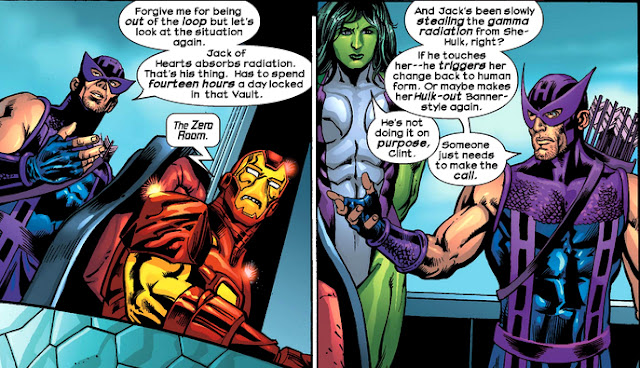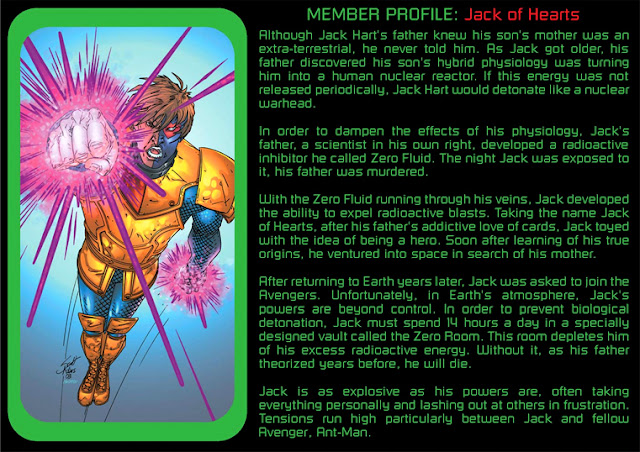Meetings held by the Avengers have seldom failed to disappoint as a means of pivoting the story in one direction or another, while the topics of discussions themselves are at times riveting given the diverse backgrounds of those seated at the meeting table who might have input to add to a course of action or points they wish to address. Such a discussion occurs following two recent incidents--one, taking place in South Dakota, as a deadly toxic cloud released by the Red Skull swept through the area and resulted in the deaths of nearly two-thousand people... and the second in Idaho, where the She-Hulk
raged out of control after being inadvertently affected by the radiation-based power of fellow Avenger the Jack of Hearts.
And so the subject now turns to Jack (as well as the She-Hulk), and the risk to She-Hulk with both of them being present on the team. All too quickly, however, it's Jack who becomes the focus of the discussion--and his disposition, the conundrum.
As Hawkeye has indicated in so many words, there really is no problem here that requires extended debate: Since Jack continues to require treatment for his current condition, and his proximity to the She-Hulk is an issue, the transfer to Stark Labs is a sensible solution while that treatment continues, after which he would be welcome to return to the Avengers. But as we see, his status as an Avenger is called into question by Scott Lang, the Ant-Man, who has butted heads with Jack every now and then. On the surface, Scott appears to simply want to make this an easier decision on everyone's part, based on his own concerns about Jack--but the possibility that this has become personal for Scott can't be overlooked.


After realizing that Captain America is strongly in Jack's corner in terms of being given every chance to excel in the Avengers, Scott subsequently attempts to smooth things over between them; but in the middle of their conversation, he's interrupted by a call alerting him that his daughter, Cassie, has become involved in a hostage situation at her school, and he rushes to the location with a virtual horde of flying insects at his side.
As for Jack, who fully realizes that he's due soon to begin his treatment in the Zero Room, he decides to follow. At the scene, Cassie's step-father, a police officer, has also arrived with her mother, and we learn more of Cooley, the deeply disturbed man that is holding Cassie. Ant-Man, of course, has a way of bypassing red tape and going straight to the source--but Cooley will prove to be more dangerous than Ant-Man, or the reader, realizes.
It's a niggling distraction to this scene to keep seeing Cooley somehow repeatedly getting his hands on his gun, apparently even managing to pack a second gun in his casual attire (seemingly for the sole purpose of allowing him to get the drop on Ant-Man)--while the Jack of Hearts, with an elevated vantage point ideal for anyone to keep tabs on a situation like this, nevertheless has the impression that he can safely leave things in Scott's hands even with a gun within this consumed man's reach.
Fortunately, Jack's hearing works better than his peripheral vision. But in running out of time, Jack faces his moment of reckoning with Scott--with himself--and with fulfilling his role as an Avenger in the moments of life he has left.



Whatever Scott may have felt about Jack's solution to this problem, it's clear that he means to remember him well--and as an Avenger, a sentiment that Scott would have disagreed with not so long ago. Yet Cooley's forced-upon fate also calls into question what has always been the problem with the name "Avenger," which by definition implies the intent to inflict harm in return for harm done to another. With few exceptions, the Avengers' interpretation of the name has always translated to bringing the perpetrator(s) to justice (i.e., the law); but there have been exceptions--team members breaking ranks and deciding to slay the Kree Supreme Intelligence, for example... and now, the Jack of Hearts acting as judge, jury, and executioner in the case of Cooley, actions which are in direct conflict with Section Four of the team's charter. One could argue that Jack's inability to fully integrate himself into the team could explain his literal adoption of the team name in Cooley's case and why he felt it his responsibility to (pardon the word) execute the man's punishment--and while Scott certainly seems willing to look the other way in that regard, I for one would like to be in that meeting room when he makes his report and the others attempt to reconcile themselves with Jack's actions.
Though in regard to Jack's fate, there are likely those Avengers readers who remember him being not so dead just a few issues later--but he was the next best thing as far as the Scarlet Witch was concerned, as we've seen in that story's separate post.








































